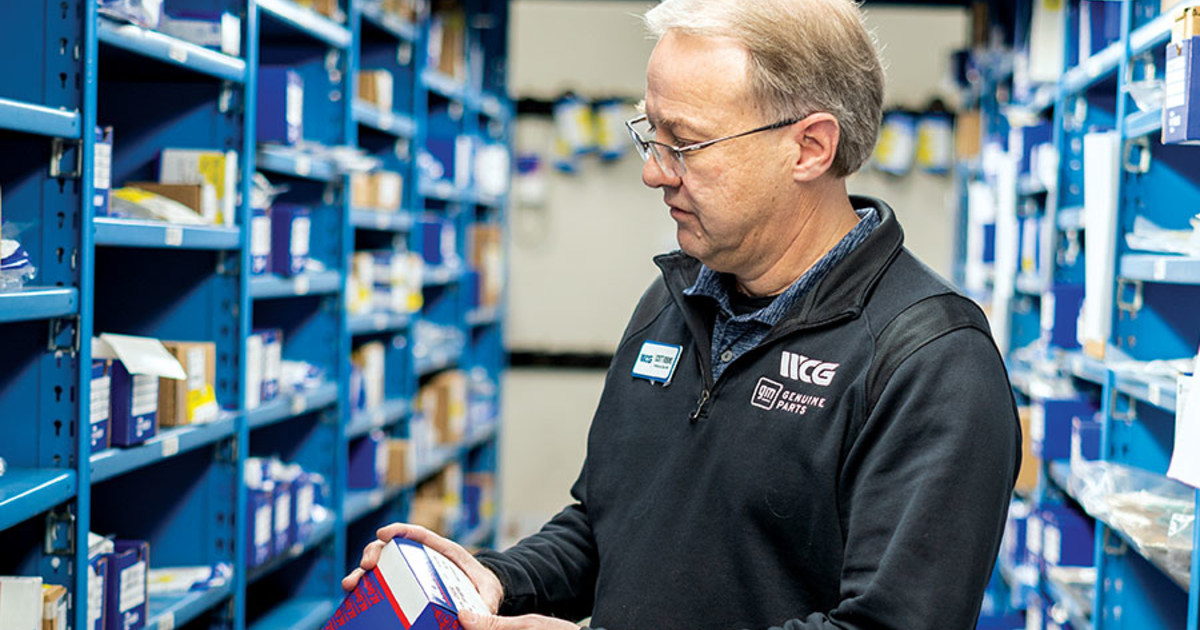
In the spring of 2021, $150,000 of Scott Robins’ $1.6 million parts inventory was considered obsolete — meaning it had been sitting in inventory for at least 13 months without being sold.
“The chances of those parts selling are pretty slim when they get to that age with no sales and orders,” said Robins, parts manager at Weld County Garage Buick-GMC in Greeley, Colo.
Obsolescence is a costly monthly expense that drains revenues. To address the problem, Robins turned to parts inventory and management service provider PartsEdge. After using the service last year, his dealership reported a 96 percent reduction in non-Retail Inventory Management obsolete inventory and an overall reduction of 87 percent in obsolescence.
RIM is GM’s dealer inventory program, meaning the automaker will buy back unsold parts. Other purchased parts, such as special orders, are not protected.
According to the National Automobile Dealers Association, the service and parts department can account for nearly half of a dealership’s gross profit. But parts obsolescence can take a toll on those profits, said Kaylee Felio, PartsEdge sales and marketing manager.
She said every dealer will have some obsolescence, but it becomes a problem when more than 15 percent of the inventory has been on the shelves for 13 months or longer.
“They take up space on the shelf where you could be using that space for something that you’re selling a lot of,” Robins said.
The most common causes of obsolete parts is when a dealer overorders, doesn’t return parts on time or orders the wrong parts and can’t return them, Felio said. It can also become an issue if warranty parts are ordered for a customer who never gets the repair done. Dealers can’t have the customer prepay for warranty repairs and customers may feel less compelled to get the repair completed, she said.
Robins said he’d sell the unsold parts online for 50 cents on the dollar. Or he would write parts off that wouldn’t sell even at a large discount, he said.
PartsEdge, which has just over 200 new-car dealership clients, helps ensure parts departments have less invested, more of the right parts to sell and very minimal obsolete parts, Felio said.
“The goal is to have just enough parts to service the repairs you need,” while keeping a lean inventory, Felio said.
PartsEdge provides a better way to more precisely track inventory by breaking it into five categories:
1. Productive stock (stock that’s selling)
2. Excess stock (stock that exceeds the system’s best stocking level)
3. Forced stock (a part that is special ordered because of demand and wasn’t in stock)
4. Technical obsolescence (parts haven’t had a sale or been receipted into the system in seven to 12 months)
5. Obsolescence (the part hasn’t sold or been receipted into the system in 13 months).
Providing more granular control over how the dealership management system handles inventory gives parts managers a better understanding and hold over whether they need to stock parts, Felio said. The company also provides a regular inventory report.
Felio said the way a parts manager looks at their data generally makes it difficult to see “the domino effect of obsolescence.” Improving tracking, helping parts managers understand the data better and sending an inventory performance report every month gives parts managers “the tools and strategies they need to keep [obsolescence] from growing,” she said.
Robins said there was an initial expense of getting rid of the existing obsolescence. He now stays in front of the problem and hasn’t had to sell for half of what he paid for it.
“That translates to net profit because you don’t have those expenses that you were dealing with before,” he said.
He said his protected inventory — parts the manufacturer guarantees to take back if not sold — is 12 percent higher than it was before working with PartsEdge. Before adopting the program, his monthly obsolescence was $4,000 to $5,000 more than his return reserves could cover. If he got 50 cents on the dollar for $5,000 worth of parts, the $2,500 made doesn’t include the time needed to generate those orders, ship them to the dealer and pay shipping fees, he said. Robins said there now is more room on his shelves for parts that sell.
Felio said some dealers don’t want to throw away their obsolescence because they invested the money. But they need to learn to let go of the mistakes “so that it doesn’t tie up money that could be better used.”
As a starting point in working proactively with an obsolescence issue, she advised parts managers conduct a basic calculation in the “7- to 12-month no sale/no receipt category” — those parts that have an 85 to 95 percent chance of never selling and becoming obsolete. Divide the total value of those parts by six. That amount represents the monthly average of how much your obsolescence will grow.
If the number is $5,000 and there isn’t $5,000 in return allowances from the manufacturer, offset the difference by having an accrual allowance from gross profits. Felio also suggested having processes in place for customers to prepay for non-warranty parts and having strict procedures on special orders because often there’s no follow-through from customers. Having a process to ensure people get the repairs done is key, she said.
Robins’ advice on obsolescence is to avoid sticking with the same system.
“If you just keep doing the same old thing, you’ll always have that extra obsolescence that you have got to sell at a reduced rate,” he said.
Robins emphasized that you won’t see results from PartsEdge within the first few months because it takes time to get the system set up and organized. But before long, it starts coming together and the puzzle pieces begin to work, he said.
Now he can handle his “manageable” amount of obsolescence with the money he gets through return reserve from the manufacturer which, he said, “I never thought I’d be able to do.”